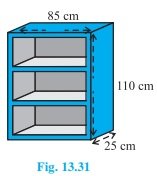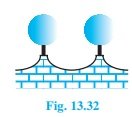NCERT Solutions Class 9 Maths
Chapter – 13 (Surface Areas and Volumes)
The NCERT Solutions in English Language for Class 9 Mathematics Chapter – 13 Surface Areas and Volumes Exercise 13.9 has been provided here to help the students in solving the questions from this exercise.
Chapter 13: Surface Areas and Volumes
- NCERT Solution Class 9 Maths Ex – 13.1
- NCERT Solution Class 9 Maths Ex – 13.2
- NCERT Solution Class 9 Maths Ex – 13.3
- NCERT Solution Class 9 Maths Ex – 13.4
- NCERT Solution Class 9 Maths Ex – 13.5
- NCERT Solution Class 9 Maths Ex – 13.6
- NCERT Solution Class 9 Maths Ex – 13.7
- NCERT Solution Class 9 Maths Ex – 13.8
Exercise – 13.9
1. A wooden bookshelf has external dimensions as follows: Height = 110cm, Depth = 25cm, Breadth = 85cm (see fig. 13.31). The thickness of the plank is 5cm everywhere. The external faces are to be polished, and the inner faces are to be painted. If the rate of polishing is 20 paise per cm2 and the rate of painting is 10 paise per cm2, find the total expenses required for polishing and painting the surface of the bookshelf.

Answer – The external dimensions of the bookshelf,
Breadth, B = 85 cm
Depth, D = 25 cm
Height, H = 110 cm
The thickness of the plank, t = 5 cm
Internal measures of the bookshelf is,
The breadth of each shelf, b = B – 2t
⇒ b = 85 cm – 2 × 5 cm = 75 cm
Depth of each shelf, d = D – t
⇒ d = 25 cm – 5 cm = 20 cm
Height of each shelf, h = H – 4t
= (110 cm – 4 × 5 cm) ÷ 3
= 90 cm / 3
= 30 cm
Now, Surface area to be polished = External 5 surfaces of the bookshelf + border of the shelf
= 2(B + H) D + BH + 2Ht + 4bt
= [2 × (85 cm + 110 cm) × 25 cm] + (85 cm × 110 cm) + (2 × 110 cm × 5 cm) + (4 × 75 cm × 5 cm)
= 9750 cm2 + 9350 cm2 + 1100 cm2 + 1500 cm2
= 21700 cm2
Cost of polishing at the rate of 20 paise per cm2 = 21700 cm2 × (₹ 20/100) / cm2
= ₹ 4340
Surface area to be painted = Internal 5 surfaces of 3 shelves
= 3 [2(b + h)d + bh]
= 3 [2 × (75 cm + 30 cm) × 20 cm + (75 cm × 30 cm)]
= 3 [4200cm2 + 2250 cm2]
= 3 × 6450 cm2
= 19350 cm2
Cost of painting at the rate of 10 paise per cm2 = 19350 cm2 × (₹ 10/100) / cm2
= ₹ 1935
Total expense required for polishing and painting = ₹ 4340 + ₹ 1935
= ₹ 6275
Thus, the total expense required for polishing and painting the surface of the bookshelf is ₹ 6275.
2. The front compound wall of a house is decorated by wooden spheres of diameter 21 cm, placed on small supports as shown in fig. 13.32. Eight such spheres are used forth is the purpose and are to be painted silver. Each support is a cylinder of radius 1.5cm and height 7cm and is to be painted black. Find the cost of paint required if silver paint costs 25 paise per cm2, and black paint costs 5 paise per cm2.

Answer –
Diameter of the wooden sphere = 21 cm
The radius (R) of the wooden sphere = cm
Surface area for wooden sphere = 4πR2
= 4 × ×
cm ×
cm
= 1386 cm2
Since the support is a cylinder of radius, r = 1.5 cm
Area of the circular end of the cylinder = πr2
= × 1.5 cm × 1.5 cm
= 7.07 cm2
So, the area of each wooden sphere to be painted = 1386 cm2 – 7.07 cm2 = 1378.93 cm2
Total area of the 8 spheres to be painted = 8 × 1378.93 cm2 = 11031.44 cm2
Cost of silver painting the wooden spheres at the rate of 25 paise per cm2
= 11031.44 × ₹ (25/100)
= ₹ 2757.86
Now,
Radius of the cylinder, r = 1.5 cm
Height of the cylinder, h = 7 cm
Curve surface area of the cylinder = 2πrh
= 2 × × 1.5 cm × 7 cm
= 66 cm2
CSA of 8 cylindrical support to be painted = 8 × 66 cm2 = 528 cm2
Cost of black painting the cylindrical support at 5 paise per cm2
= 528 × ₹ (5/100)
= ₹ 26.40
Hence the cost of paint required = ₹ 2757.86 + ₹ 26.40
= ₹ 2784.26
Thus, the cost of paint required is ₹ 2784.26 (approx.)
3. The diameter of a sphere is decreased by 25%. By what per cent does its curved surface area decrease?
Answer –
Let the radius of the sphere = r
Then its diameter, d= 2r
The Surface area of a sphere = 4πr2
The Curved surface area of the sphere = 4πr2
Now it is given in the question that the diameter of the sphere is decreased by 25% hence a new sphere is formed.
Therefore, the diameter of the new sphere can be written as:
= 2r – (25%) of (2r)
= 2r – × (2r)
= 2r – (r/2)
= 3r/2
Radius of the new sphere = ×
=
Hence, curved surface area of the new sphere = 4π
= 4π
=
Now, decrease in the original curved surface area = 4πr –
=
=
So, the percentage decrease in the curved surface area is,
= ×
× 100%
= × 100%
= 43.75%
Therefore, the percentage decrease in the surface area of the sphere is 43.75% .

Leave a Reply